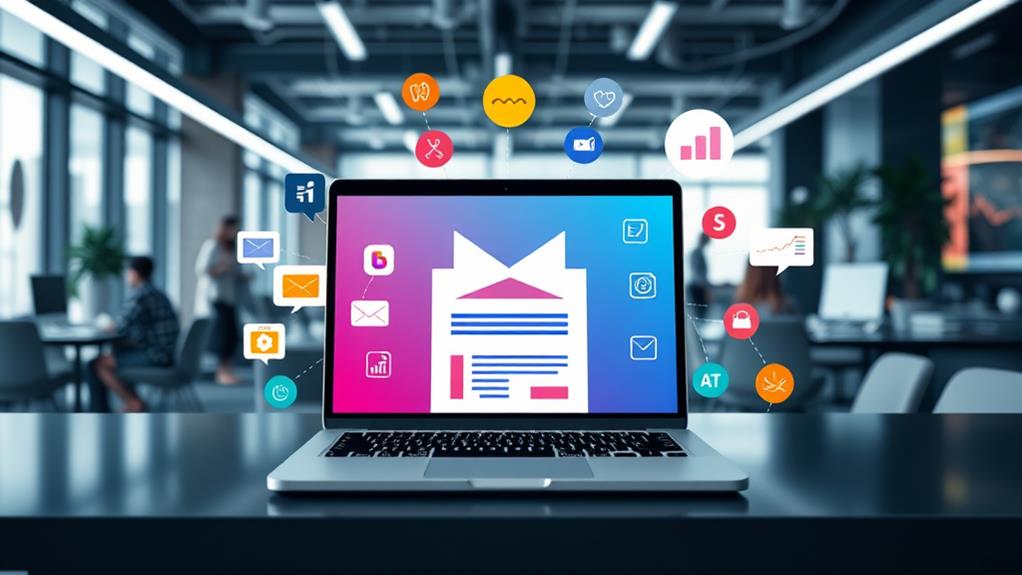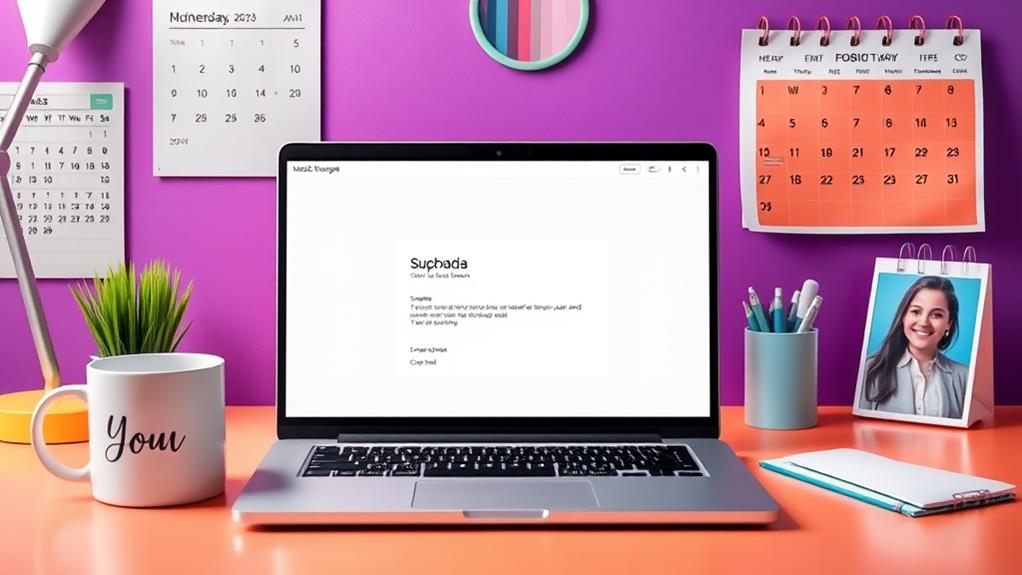Striking the right balance between personalization and automation in emails is essential for achieving optimal marketing outcomes. Personalization enhances customer engagement, with 80% of consumers preferring it, leading to a 20% sales increase. Meanwhile, automation streamlines processes, saving marketers up to 30% of their time and improving campaign success. Integrating these strategies through dynamic content and behavioral triggers maximizes efficiency and relevance, fostering stronger customer relationships. However, careful audience segmentation and data-driven insights are vital to avoid over-automation and maintain message relevance. A balanced approach not only heightens conversion rates but can also keep your brand top-of-mind for long-term loyalty. Learn further strategies to seamlessly blend these elements.
Key Takeaways
- Integrate dynamic content blocks to tailor messaging, enhancing engagement without losing automation's efficiency.
- Use audience segmentation to ensure personalized content reaches the right recipients, balancing scale with relevance.
- Implement behavioral triggers for timely, automated communications that maintain a personal touch.
- Prioritize key segments to manage resources effectively, achieving a balance between personalization and automation.
- Continuously perform A/B testing to optimize the integration of personalization and automation strategies.
Defining Email Personalization
In an era where consumer expectations are at an all-time high, email personalization emerges as a vital strategy for marketers aiming to boost engagement and drive conversions. By tailoring content to recipient preferences, behaviors, and past interactions, email personalization considerably raises content relevance, making each communication feel bespoke and valuable. This approach not only resonates with the 80% of consumers who favor brands that provide personalized experiences but also drives a measurable 20% increase in sales, underscoring the effectiveness of targeted messaging.
At the core of email personalization is the strategic use of recipient data to craft messages that speak directly to individual needs. Dynamic content blocks play an essential role in this process, allowing marketers to seamlessly adjust the content within emails based on distinct recipient data. This flexibility guarantees that each recipient receives content that is both relevant and timely, enhancing their engagement with the brand.
Additionally, implementing behavioral triggers such as follow-ups for abandoned carts guarantees communications are not only personalized but also timely, aligning with recipient preferences. This data-driven strategy enhances the personalization efforts, fostering a deeper connection between brands and their consumers.
Exploring Email Automation
Email automation, a cornerstone of modern digital marketing, revolutionizes how marketers engage with their audiences by streamlining repetitive tasks and enabling the management of extensive campaigns with efficiency. By harnessing automation tools, marketers are able to save up to 30% of their time, allowing for a more strategic focus on campaign creativity and optimization.
These tools leverage user behaviors to trigger specific actions, such as sending follow-up emails to customers who abandon their carts, which enhances engagement and conversion rates.
Segmentation plays a vital role in the effectiveness of automated emails. By targeting specific audiences based on behavior and preferences, marketers can craft messages that resonate with individual recipients, resulting in higher open and click-through rates.
Leading platforms like HubSpot and Mailchimp offer sophisticated automation features, facilitating dynamic content personalization that keeps email communications relevant and engaging.
Consistent implementation of email automation not only improves operational efficiency but also enhances return on investment (ROI). A staggering 75% of marketers report reduced human error and increased campaign success.
Fundamentally, email automation, driven by insightful data and user behaviors, is pivotal in crafting impactful, targeted messaging that resonates with audiences.
Benefits of a Balanced Approach
Striking a harmonious balance between personalization and automation in email marketing can greatly boost engagement rates and drive sales. Personalized emails have been shown to increase sales by 20% compared to their generic counterparts, illustrating the potent impact of tailored content. This approach not only raises engagement rates but also fosters customer loyalty, as 80% of consumers prefer brands that deliver personalized experiences.
Automation, on the other hand, considerably enhances efficiency by saving marketers up to 30% of their time. This efficiency allows marketers to focus on crafting personalized interactions that enrich customer experiences. Through effective segmentation, automation guarantees targeted outreach, with 74% of marketers reporting improved customer engagement when personalization is applied effectively.
The integration of automation and personalization leads to higher conversion rates. By delivering consistently relevant content, businesses can reinforce customer relationships, encouraging repeat purchases and loyalty.
This balanced strategy not only maximizes marketing efforts but also guarantees that the brand remains top-of-mind for consumers. Ultimately, the synergy between personalization and automation empowers marketers to deliver impactful messages that resonate with their audience, driving both short-term engagement and long-term customer loyalty.
Strategies for Effective Integration
Achieving a seamless integration of personalization and automation in email marketing requires strategic planning and execution. By leveraging dynamic content blocks, marketers can tailor messages based on recipient data, ensuring that each communication resonates with its audience.
This approach enhances recipient engagement by delivering content that is both relevant and timely, while still utilizing automation for efficiency in sending processes.
Segmenting your audience through behavior and demographic insights enables automated list management, ensuring personalized content reaches the right recipients at ideal times.
Advanced tools like HubSpot and ActiveCampaign facilitate this process, providing features for segmentation and automation that integrate personalized elements to boost engagement rates.
Implementing behavioral triggers, such as follow-ups for abandoned carts, allows for timely, automated communications that feel personal and relevant to individual actions.
Regular A/B testing is essential, offering data-driven insights that help determine the most effective balance between personalization and automation.
Overcoming Common Challenges
Steering through the intricacies of email marketing often presents challenges that require a meticulous approach to overcome. One significant hurdle is over-automation, which can dilute message relevance, leading to disengagement. To counter this, audience segmentation becomes paramount, allowing marketers to tailor content that resonates with specific groups. Despite the benefits, balancing personalization with scale often demands substantial resources. Prioritizing key segments can help manage these resources effectively, guaranteeing engagement is not compromised.
Data privacy concerns add another layer of complexity. Consumers are increasingly favoring brands that offer personalized experiences while respecting data usage. Transparency and compliance measures are essential to maintain trust and drive engagement. Furthermore, integrating various marketing tools can be an arduous task, yet selecting compatible platforms is critical for seamless automation and personalization.
The evolving market landscape demands continuous training and adaptation. Staying abreast of trends guarantees strategies remain effective and relevant. Below is a table illustrating core challenges and solutions:
| Challenge | Solution |
|---|---|
| Over-automation | Audience segmentation |
| Data privacy concerns | Transparent compliance |
| Resource-intensive efforts | Prioritizing key audience segments |
| Tool integration complexity | Selecting compatible platforms |
Frequently Asked Questions
What Is the Difference Between Email Segmentation and Personalization?
Email segmentation involves grouping a target audience based on shared characteristics using segmentation strategies, while personalization tailors engaging content to individual preferences through data-driven insights, thereby enhancing targeted messaging and fostering more meaningful connections with recipients.
What Do You Understand About Personalization and Automation as Part of Email Marketing?
Personalization tailors emails to the target audience's preferences, enhancing customer engagement, while automation facilitates efficient delivery. Together, they create data-driven, engaging content, ensuring targeted messaging that resonates and drives meaningful interactions in email marketing.
What Is Personalization in Emails?
Personalization in emails involves creating personalized content tailored to recipient preferences and demographics. This targeted messaging enhances audience engagement by delivering data-driven, engaging content that aligns with individual behaviors, resulting in more effective communication and increased marketing success.
Why Is Automation the Smartest Choice for Email Marketing?
Automation in email marketing offers substantial benefits, including efficiency gains through streamlined processes and reduced errors. It enables data-driven, targeted messaging that enhances engagement, while effectively managing large audiences and maintaining consistent brand communication, ultimately maximizing ROI.
Conclusion
Achieving an ideal balance between personalization and automation in email communication enhances engagement and effectiveness. A data-driven approach guarantees targeted messaging, while automation streamlines processes, allowing for scalability and efficiency. Personalization fosters deeper connections by delivering engaging content tailored to recipient preferences. By integrating both elements strategically, organizations can overcome common challenges, such as maintaining consistency and managing resources, thereby refining email campaigns for maximum impact and fostering stronger relationships with audiences.




